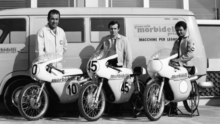April 23, 2007 – Powersports Business’ 2007 Executive of the Year
By Steve Bauer
Managing Editor
One glance down from Paolo Timoni’s 17th floor New York City office provides some insight to the inspiration behind the industry’s most unique and challenging marketing campaign: an endless stream of cars inching along the city’s narrow urban canyons around one of the world’s busiest transportation hubs, Grand Central Station.
It’s the perfect environment for Timoni to discuss the Piaggio Group’s unique marketing strategy that is aimed at opening a line of communication with consumers about the environment. It’s a dialogue that appears to be slowly opening the eyes — and wallets — of a gas-happy society.
With a continuous flow of advertising focused on the benefits scooters could have on the environment, Timoni and Piaggio have positioned themselves into a unique position in the powersports industry — a company that caters toward a consumer’s social conscience. It’s an innovative marketing strategy that seems to be making a difference among American consumers and lawmakers, and it’s why Timoni has been named Powersports Business’ 2007 Executive of the Year.
Timoni wants to make it clear, however, that Piaggio isn’t attempting to make Americans feel guilty over owning SUVs and gas-guzzling cars. Instead, he insists the company is trying to change behaviors and opinions toward scooters as little more than a novelty.
“Piaggio isn’t saying to the American consumer that they need to choose a scooter over an SUV,” he said, “because we know people love their SUVs. The message that we’re trying to convey is that contrary to what the automobile industry is trying to tell you, you don’t have to choose between a Toyota Prius or an SUV. Their message is that if you’re a bad guy without a social conscience, then go ahead a buy a big SUV. But if you care about the environment, you need to go out and buy an economical car like the Toyota Prius. Our message is that you can have both.
“You can combine your SUV with a scooter, so you drive the scooter in one situation, and the SUV in another situation. You’ll be as efficient if not more than someone who owns only a Prius.”
Timoni admits grabbing the American consumers’ attention and trying to convince them to commute on a scooter instead of their SUV is a huge obstacle. To do that, he says, the company has to continually shower the American public with information to educate them.
“Unfortunately it’s not enough to say what we have to once or twice. We have to do it several times,” he said. “At some points we’ve tried to leverage the debate in terms of gas prices and oil consumption, at other times we do it in regard to global warming or traffic congestion.”
One of the biggest marketing moves Piaggio made in 2006 was the introduction of “Vespanomics” — a campaign that explains how the use of two-wheelers can reduce oil consumption, carbon dioxide emissions and traffic congestion. But that venture was only the tip of the iceberg.
It also placed a full-page ad in the New York Times urging all U.S. mayors to engage in an open dialogue about energy efficiency, which in turn resulted in several mayors of major U.S. cities leading the charge to make their cities more scooter-friendly. The company also began sponsoring independent consumer surveys and environmental studies that show what benefits scooters can have on the environment and traffic congestion, and that many Americans might be willing to purchase a scooter because of it.
Cultures Collide
Timoni admits Piaggio’s approach is a risky one, but he believes that despite what many feel is a “me-first” society, Americans and their love affair with cars is not that different than the culture in Europe, where scooters are more prominent.
“When people think about Europe, the first thing that comes to mind is that scooters are everywhere. But if you take a closer look at the situation there, it is only a sub-section of the population,” he said. “About 20 million Europeans are using a scooter. But out of 300 million people in Europe, close to 200 million drive cars. So like America, you have a majority of people who drive cars and only cars.”
Timoni says the major difference between Europeans and Americans is that Europeans have developed a culture where they use their disposable income to purchase a scooter for commuting purposes, where Americans will use it to purchase another car.
“If you go to Milan, Paris or London, you will find professionals like lawyers and doctors using scooters to commute to work,” he said. “But it’s not that these people don’t own a car. In fact, they usually have big and luxurious ones. But they only use the car when they have to take the family out during the weekend, for example. But in the day-to-day situation, commuting to work or running to the market, they choose scooters because in that vehicle they can move around the city in a much faster and more convenient way.”
Eye-Opening Numbers
Although progress has been slow, Timoni says there are signs that the tide is turning when it comes to Americans and their attitudes toward scooters. He points to a traffic simulation recently conducted in partnership with engineering and planning firm Sam Schwartz PLLC using an industry-standard tool deployed by transportation engineers. The traffic model, focusing on a central section of midtown Manhattan in New York City, incorporated scooters into the traffic mix in 10 percent increments — examining the impact of moving from 100 percent cars (including small SUVs, vans, etc.), to 90 percent cars/10 percent scooters, to 80 percent cars/20 percent scooters, etc. When the simulation shifted the daytime vehicle mix to 80 percent cars/20 percent scooters, the firm concluded the following:
• A decrease in delay of more than 4.6 million hours per year, which translates to time savings of nearly 100 working hours per person.
• A reduction in carbon dioxide emissions by more than 26,000 tons per year.
• A decrease in fuel consumption by more than 2.5 million gallons per year.
• A savings for New York City alone of more than $122 million per year in fuel and labor productivity.
It’s numbers like that which have grabbed the attention of the American public and legislators, and which Timoni says is the start of changing opinions.
“It only takes a few to start using scooters,” he said, “and then everybody, including car drivers, can benefit. And our surveys back up our belief that once people see what scooters can do for traffic congestion and the environment, they’re more willing to consider using one. A recent survey we sponsored said that more than 30 percent of Americans would consider purchasing a scooter if it would help ease global warming. That percentage would never have been so high, say two years ago.”
Slow But Steady Growth
Whether Piaggio’s surveys and studies have had a direct impact on its sales of scooters is yet to be seen, but the company did see a sales increase in North America of 59 percent last year, and Timoni expects that number to stay steady, if not rise, in the future.
“In terms of revenue growth, a lot will depend on overall market performance,” he said. “The overall scooter market had a decline of 5 percent, where we had a growth of 14 percent. This year, January and February, we had negative growth compared to last year, but March has been wonderful. Sales have increased more than 40 percent over last year. At this point it’s a little challenging to say what the total growth will be, but with a flat market I think we will be in the 15 percent growth area. If the market has a more sustained pace, we could easily see 25-30 percent growth.”
Timoni believes the company’s marketing strategy will pay off financially sooner rather than later, noting the faster the American public is educated on the benefits of scooters, the faster Piaggio Group USA’s growth will be.
“Currently the scooter market is very small. Our estimate is that there are less than 1 million people using scooters in the U.S.,” he said. “We don’t imagine a scenario where there will be 300 million people using scooters, but we see the potential over time where there could be 20-30 million scooter-users. It might not explode in the next six months, but we see the potential two or three years down the road. We’re committed to first developing the market and then serving it.”
Timoni also notes that one key to reaching those numbers is to get the Motorcycle Industry Council (MIC) more engaged in the environmental debate, something he says is vital to spreading the company’s message.
“My hope is that we’ll be able to engage ourselves with the MIC, to have them embrace these topics and initiatives as a priority,” he said. “So far the MIC has been very positive. They’ve endorsed some of the things we’ve been doing so far, but we still need to finalize a solid plan. Hopefully soon we’ll have some initiative that we’ll be able to announce in partnership with the MIC.”
Arctic Cat Partnership
Part of Piaggio’s broader marketing strategy for America was to increase its presence in the U.S. market, and its partnership with Arctic Cat in early 2006 has helped boost the company’s dealer network beyond major urban markets.
“We wanted to see if we could develop a customer base for our vehicles in some of the smaller U.S. markets where we previously didn’t have a presence,” Timoni said. “At the same time we reciprocated by opening some doors for them in Europe. My understanding is that they’re progressing well in Europe, as are we. As far as placing our product in Arctic Cat’s dealerships, in some regions we can’t expect our product to bloom right away, like they would in New York or San Francisco. It takes time to see if you can develop a clientele in some of these smaller markets. So right now it’s been positive. The numbers aren’t huge of course, but we’re taking a very patient approach and really looking to develop a strong core customer base at the national level.”
Internal Changes
Another big move for the company in 2006 was a change in IT systems, which now links Piaggio Group USA to its corporate headquarters in Italy. Timoni says this change has led to a vast improvement in terms of parts availability and the company’s ability to serve dealers.
“We have made some really good improvements in parts availability and our capability to serve dealers,” he said, “although we cannot claim the job has been completed. We’re still working on, for example, the manifold casting. We’re installing sophisticated software that will allow us to better forecast the demands for parts and accessories. We have the fortune and the problem of growing very fast.
“For a company that’s nearly doubling its dealer base on an annual basis and where several new products are introduced, the whole demand for custom process is more complicated, and this is why our fill rate for parts is 90 percent within five days. We are still not at 95-98 percent fill rate, which is our target. Our system is evolving so much that forecasting and planning is a really complex exercise. Compared to two years ago, probably 75-80 percent of what needs to be accomplished has been, and we still have a little ways to go to meet our dealers’ and customers’ expectations.”
Stay The Course
Timoni hints that with all the change the company has been through, dealers and consumers can expect bigger and better things on the horizon, including the continuation of the company’s environmentally based marketing strategy.
“We’ll try to continue to be as creative as we have been to gain the attention of the mass market of the American consumer,” he said. “Clearly a lot of focus and emphasis will be on our MP3 three-wheel scooters. We feel that the market will be very receptive to this very innovative product. But because our success implies changing behavior in a large share of the population, we must continue to have this open dialogue with the American public, and through this dialogue we can try to share with this potential customer all the benefits and all the reasons why we’re encouraging this change in behavior. If we can keep people’s attention and continue to have this dialogue with them, that makes our communication job easier and in the long run benefit everyone.”








